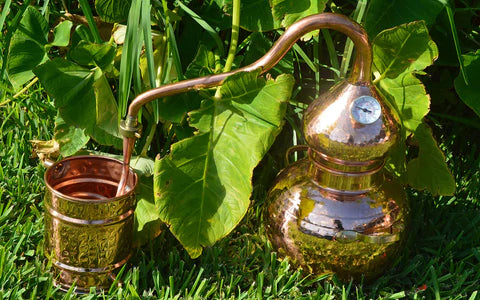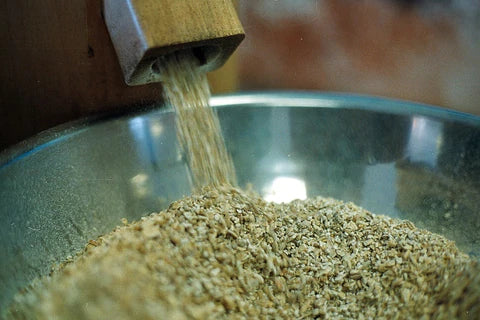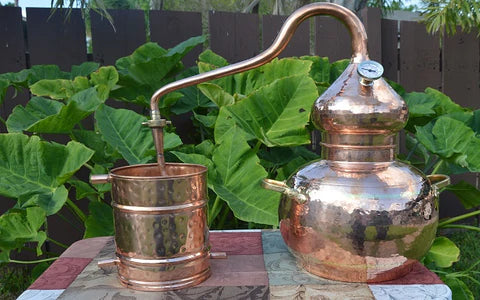Alcohol distillation is an ancient process that is both an art and a science. It’s easy, but not as easy as simply turning it on and watching it go. Diligent distillers know that you have to keep an eye on the temperature control when distilling, and you also have to keep an eye on the final product - the distillate - so that you can make the safest and best tasting spirit.
One trick of the experts that makes their product so good is their practiced and precise “cuts” during the still’s run. A “cut” is when you switch the containers that are catching the distillate coming out of the condenser coil. You “cut” the alcohol stream dripping from the condenser coil when switching from a jar which contains distillate to an empty one. But, the timing of when you make these cuts is very, very important in producing a spirit that anyone will want to drink.
The Four Stages of Your Moonshine Run
You may have heard old legends about how moonshine will “make you go blind.” Even though this is an exaggeration, it is true that moonshine that isn’t made well can make you sick. Read our run-down on how to distill whiskey and moonshine, to get an overview of safety measures you should take throughout the run. Be aware of alcohols that are being produced during the different stages of your moonshine run, so that you can avoid earning any reputation for your moonshine as being unsafe.
You may need more than one container for each stage of the run, so make sure to label each appropriately. If you have multiple containers for each stage of the run, that’s okay. Consider only a change of containers as a “cut” if you are going from one stage of the run to another.
The Foreshots
At each stage of the run, different alcohols are vaporized and make their way into the collection cup. The alcohol that makes fine, high-quality moonshine, is ethanol, which boils at a temperature of 175 degrees Fahrenheit. Other chemicals and types of alcohols, such as methanol, boil at lower temperatures and will be collected in your cup or jar after being condensed in the coil. These chemicals are poisonous. Not only will they ruin the taste of your moonshine (or whatever alcohol you’re distilling), if they make their way into your final product, they can make people very ill.
Generally, distillers make the first cut in the run when the temperature in the still’s pot reaches approximately 175-180 degrees Fahrenheit. At this temperature, the ethanol in the wash will begin to vaporize, and you can be sure that the distillate collected before that point contains most of the methanol and other poisonous compounds. After making the first cut, throw away the contents of your first container.
The contents of this first container of all the distillate collected before your run reaches this temperature are called the “foreshots.” The foreshots should ultimately be about 10% of the final amount of your distilling run. It is always best to make the cut a little later rather than earlier, to be sure that all the poisonous chemicals are tossed out.
The Heads
As the temperature continues to increase, ethanol will boil, and you will be distilling real spirits. But, while the temperature in the still’s pot is climbing through the range of about 175 degrees Fahrenheit to about 185 degrees Fahrenheit, the distillate will still contain many traces of non-ethanol chemicals that can make your final product have a bit more “bite” and flavor if they are added to it.
For a product like whiskey or Scotch, this might be ideal, because the complexity of those alcohols comes from the combination of trace chemicals. However, for a product like moonshine or vodka, which are ideally flavorless, trace chemicals alter and affect the taste of your product negatively.
The second cut you will make in your run will be around the 185 - 190 degree temperature range. The distillate collected after the foreshots and before the second cut is called the “heads” of the run. Set the heads aside for further distillation, or to combine the right amount with your final distillate to flavor the alcohol the way you like.
The heads should total about 20-30%% of the final amount of your run. It’s always best to make this cut a little later, rather than earlier, and collect some of the hearts with your heads, instead of the other way around.
The Hearts
The best part of the run is the distillate that contains the most ethanol. This is called the “hearts” section of your run. Many professionals and long-time distillers agree that this is the portion of the run from about 190 degrees Fahrenheit to about 200 or 205 degrees. Of course, it depends on the still.
Although the boiling point of ethanol is 175 degrees Fahrenheit, the mash in your still is not pure ethanol. Depending on the ingredients and other factors, you should expect that most of the pure ethanol in your run is boiling off when the still’s pot shows higher temperature than 175.
The hearts will probably total to 30% or so of the final amount of your alcohol run. It is always better to make this cut early, to keep the hearts as pure as possible. It’s better to mix some hearts into your tails, than some tails into your hearts.
The Tails
After the run reaches about 205 degrees Fahrenheit or so, there may be more steam that makes its way into your distillate. There may also be other chemicals that burn at a higher temperature than ethanol, which can give this portion of the distillate a flavor that isn’t quite what you’re after. This part of the run is called the “tails” and can total as much as 20-30% of your run. Set the tails aside to be further distilled.
At 212 degrees Fahrenheit, water boils. When the temperature in the pot of your still reaches 212 degrees, you can go ahead and turn off the heat source for your still. The temperature inside should maintain itself for a little while longer, then the temperature at the top of the column (the “onion head”) should suddenly drop, signalling the end of your run.
You can keep collecting whatever distillate comes out of the condenser coil, but it’s not worth boiling the water to get every drop of alcohol out of the alcohol wash. You’ll end up with a lot of water in your tails, which will just be distilled out again anyhow.
Allow your still to cool before disassembling, cleaning, and storing it for your next run.

Mason jars are the traditional containers for moonshine distilling
The “Feints”
The containers of heads and tails that you set aside are referred to as the “feints.” You have two options for these: you can add them into the wash with your next run, or you can distill them by themselves. If you don’t want to mix different recipes or flavors from various mashes, you might distill the feints in a smaller-size still after each alcohol run. Some people collect their feints for several runs, then do an all-feints run in a larger still; this is called the “queen’s share.” Just to be safe, you still throw out the foreshots in a queen’s share run.
It may take some practice before you learn the unique characteristics of your still that will tell you when to cut your alcohol run. During each run, take notes on the temperature of the still when you make your cut, you might also note observations like the color, clarity, flavor, and texture of the distillate during the different stages of a run, which can help you repeat successful runs and figure out where you went wrong in a batch that isn’t up to your standards.
Always enjoy your alcohol distilled at home safely and responsibly. Follow the law, practice safe distilling, and learn to maximize the hearts in each run, and you’ll be able to enjoy your moonshine with a smile.
Article by: Jim Thomas
Photo credit: Luann Snider Photography



